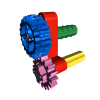Search the Community
Showing results for tags 'S-brick'.
Found 5 results
-

[MOC] MAN Lion's City articulated low floor bus
Fosapifi posted a topic in LEGO Technic, Mindstorms, Model Team and Scale Modeling
It has been quite a while since I last posted here. But this Project seems to be worth sharing with you. At 9869 parts and 8.4 kg, it is by far our largest project. The goal was to include motorized driving and pneumatic suspension without using any of the interior space. So yes, it has a real low floor going through the whole length. RC-functions: - The third axle is driven using 4 PF L motors, 2 CaDA metal u-joints and the new LEGO heavy duty diff. We destroyed many parts while prototyping. We tried to include a 2-speed gearbox, off-center diff, no diff at all and single wheel drive. The current setup is the only one which was working in the end. - The first axle is steered by a PF servo, located under the driver seat. - The bus has two separate pneumatic systems. One for the suspension and one for the doors. Both have their own manometer and pump, actuated by a PF L motor. The suspension system has 2 air tanks, the door system has 1. - The left suspension can be raised manually with a switch in the driver's cabin. The right side is operated by a PF servo. We included a check valve to enable slow kneeling. The switches are connected in such a way that the pressure in the air tanks is always kept while kneeling. The suspension system uses 22 small pneumatic cylinders and 10 shock absorbers. - The doors are also operated by a PF servo. The second and third door can be disabled separately from the driver's cabin. The system has a total of 6 cylinders. - We managed to hide a micro motor under a seat behind the first axle. It is used to unfold the wheelchair ramp. We used a red 9244a u-joint to hide the mechanism in the side wall. - A total of 8 LED pairs is used for the lighting. The functions are controlled by 4 s-bricks. For power supply we use one 84599 rechargeable battery box and one buwizz brick. The bus uses 14 extension wires and 14+ meters of hose. One of the hardest challenges was to prevent the bus from bending. The floor is only 2 studs thick and has weak spots over each axle. The roof is responsible for the rigidity while only being connected to the lower section with a few liftarms. It also houses most of the technic. There are several tight spots where every millimeter is used for hoses and wires. Problems: The suspension system is very unreliable. Many of the small cylinders leak if they are unevenly loaded. We had to buy more of them than we need and still the kneeling does not work every time. The front and rear section are only connected with one turntable in the roof and one pin in the floor which makes it hard to pick the bus up. The building time was 3 years with many breaks. We wanted to replicate the exact version of the bus which is used in Munich. Unfortunately all articulated buses with 3 doors were retired during the building process. It is very disappointing that we could not build it in blue because LEGO thinks it is a good idea to use 5 different shades of blue than releasing all basic parts in one color. As usual we published free building instructions at rebrickable: https://rebrickable.com/mocs/MOC-126294/Fosapifi/man-lions-city-g-articulated-low-floor-bus/#parts If you want to watch the instructions for entertainment, we also have a video version: https://www.youtube.com/watch?v=GiKy4xixxmo You can find a very ugly pneumatic plan in the instructions. The bellows are a further developed version of Sariel's design: https://www.youtube.com/watch?v=I8_YJK_WNpY Also big shout out to the incredible CapaCity L by krolli: https://www.eurobricks.com/forum/index.php?/forums/topic/167663-articulated-bus-like-capacityl/ -

[MOC] Lego ~Technic Camera boat | filming from the surface
896gerard posted a topic in LEGO Technic, Mindstorms, Model Team and Scale Modeling
Once in a while, every Technic builder wants to build a Lego boat. I was no exception, but there's a lots of boats being built: how to make an original boat then? I decided to not design a good-looking boat, but to make it a tool for filming. This choice asks for a boat that can be quickly placed into its filming position, which means it should be fast and agile. It should also have enough remote control range to film on big water areas. The 1980's Power Functions remote is thus completely out of the question: responds very slow and outside, there's 2 metres of range. We all must thank S-brick for existing. S-brick (or alternatives) makes this boat possible: without sufficient range, there cannot be a camera boat. Many boats have a keel and a rotating propeller at the back. A submerged plane behind the propeller acts as a rudder. Sadly, a rudder becomes less efffective at lower boat speeds and the boat reacts slowly to it: turning the rudder does not mean turning the boat, it first needs speed (and thus space!) to turn. In Dutch ditches (where I wanted to test the boat), there is not a lot of space available for maneuvering. Having a a slow-responding boat with a rudder there means the boat being into the reed all the time. I therefore eliminated the rudder and mounted the propeller on a hinge. Any hinging of the propeller system at any propeller speed the boat causes immediate turning, which is a nice direct response on the steering input. Good theory, but when a single rotating propeller is mounted on the rear, the boat will rotate along its Z-axis. I'm not sure why this happens. It may happen due to the gyroscopic effect of the propeller or due to the Lego propellers not being made for water propulsion, but anyway I had to deal with it. A second propeller placed next to the first propeller that rotates in the opposite direction seems to to the trick. However, when you mount this system on a single hinge, the (larger) system swings out quite far and easiliy hits reed in the typical tight Dutch waters I tested it in. Also, in windy waters, having a single propeller at the rear means the steering is countersteering all the time just to sail straight on! To deal with the problem, I mounted 1 propeller at the front of the boat and one steered propeller at the rear. This means the boat always tracks straight (even when the wind comes in from any side) and that the propellers can be mounted close to the boat, reducing its draft. The boat is made from 2 boat hulls to create a stable camera platform. This concept worked, it gave a lot of control. I decided to use a race buggy motor as it provides a lot of RPM at low torque, excactly what a boat needs. As no additional parts (for looking nice etc) were added, the boat was light, controllable, fast and really fun to use. The steering is a quite unusual setup (for me). It contains a rack with a 24t gear, a PF Servo motor and a ball link system. This setup had the power and speed that was needed for the steering to be quick. The video The GoPro is mounted upside down under the boat. The high speed axle to the front propeller is also visible. For water level footage, the GoPro is mounted starboard-side of the boat. As the boat only weighs 831 grams, this effects the balance a bit.. Sometimes, I used a rearward-facing camera, mounted in a Lego frame and adjustable by a large linear actuator. The same camera, facing to the front. Due to the size of the boat, there are weight restrictions. The boat wouldn't sink with a mounted DSLR camera, but it would not be stable enough when the wind increases. The Sbrick and PF battery box are mounted on the left side to keep a low center of gravity and to restore the balance (the servo is not in the middle). The boat packs some power, which is visible from the wake in the water. Thanks to S-brick the boat never went out of range so it was also a really nice toy. It might have been faster with BuWizz though, but that question might be answered later. I think this boat really makes a case for the race buggy motor. It has good RPM and power for its size and in the water it never runs out of torque (a problem that can occur on land.. ). Hopefully someday somehow it will be made compatible to Powered Up, otherwise this hero will disappear in the shady realms of the past. -

[MOC] Merlo Roto Telehandler
KirTech LAB posted a topic in LEGO Technic, Mindstorms, Model Team and Scale Modeling
Review and instructions: Hi! I’m glad to show my new MOC – it’s Merlo Roto Telehandler in 1:11 scale. Here you can see the real machine: The dimensions: 80 x 25 x 30 cm, total weight – 5,7 kg. The max height is 83 cm. The model contains approximately 5100 parts. The model has eight remote controlled functions (three S-bricks, 14 motors). 1. Four L-motors for AWD with diffs. 2. Two servo-motors with independent control for steering. We can steer normal, with reduced radius or crab. 3. Outriggers deploying – two M-motors. 4. Superstructure rotation – one XL-motor. 5. Boom raising – two M-motors. The boom is rather heavy it can’t lift significant additional weights. 6. Boom extension – one M-motor. 7. The rigs operation – one M-motor. I’ve created classic fork and crane. 8. Cab lift for visibility improvement. In addition to motorized functions the model has suspension with solid axles (eight hard shock absorbers), detailed cab and other cool features. Let’s watch the video: Photos: More photos on Flickr.com: https://www.flickr.com/photos/141718063@N06/albums/72157687306220840 The building instructions: https://rebrickable.com/mocs/MOC-22024/desert752/merlo-roto-telehandler/#comments Thanks for watching! I hope you like it :)- 23 replies
-
- s-brick
- telehandler
-
(and 2 more)
Tagged with:
-

[MOC] Street/Drift car
HorcikDesigns posted a topic in LEGO Technic, Mindstorms, Model Team and Scale Modeling
S-Brick powered Streetcar VIDEO (part one - without drifts) Full album: https://flic.kr/s/aHskxmKbsh It is driven by 5292 (buggy) motor in the back, directly connected to wheels from faster output (on 16L axle, in case you'r curious), steering is done by servo, controlled by S-Brick and it's fuel tank is original Li-Po BB. S-Brick powered Streetcar S-Brick powered Streetcar Front axle has positive caster angle for better steering performance, and it's only gearing is positioned there. (the steering 7L rack and 12t pinion.) When you see it (in case you're fast enough), you can see custom stickers, working front lights, and custom 3D printed rims (my own design). S-Brick powered Streetcar rim On the rims are original, but cut, LEGO 48×24 ZR tires. ________________________________________________________________________________ Here is version for purists, with original rims and non-modified tires (but not last configuration of stickers and rear bumper) Teaser On smoother or slippier surface (wooden floor, for example), it is capable of slightly real-looking drifts. (wait for part two of the video, please :) ) __________________________________________________________________ Here, I add the LDD file with backup model of it. Not 100% accurate, but IMO sufficient. https://www.dropbox....BACKUP.lxf?dl=0 Hope you like it :) -

[MOC] RC Camper Van with SBrick - 4 Studs Wide
SevenStuds posted a topic in LEGO Technic, Mindstorms, Model Team and Scale Modeling
So this was a quick, fun project. I gave myself the weekend to build the smallest RC car I could. My goal was 4 studs. This seemed reasonable since a battery box and SBrick are both 4 studs wide. With the width set in place, I quickly realized that making two connected parts would be the way to go so the model naturally became a camper van/RV with a trailer. The main car holds 2 micromotors and the trailer has 1 old-style battery box with the SBrick directly on top. More photo's here. Assembly photos are here. PS: I must also thank Mbmc as some of his micro RC MOCs were a good inspiration for this project.- 11 replies
-
- micromotor
- micro
- (and 5 more)
